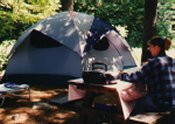How to Prepare for a Camping Trip
There is nothing more relaxing than spending some time camping in the woods or at the beach.
You can’t beat getting back to nature, enjoying the fresh air and beautiful surroundings. You can choose to camp
at primitive sites (no plumbing or electricity) or one of many campgrounds that provide everything from showers
to swimming pools. If you choose the more primitive route (it’s more fun), make sure to bring these items before
leaving home.
1. Get a good quality tent. Remember, you get what you pay for. Poor quality tents will leak
if it rains and rip easily. Camping can be a little rough, so make sure your tent can stand up to nature.
2. The tent should be large enough for whomever is going to sleep in it, plus their gear. Tents
are normally rated according to how many people can sleep comfortably, but these ratings are a bit liberal. Buy
a tent that is rated at least one more person than will actually occupy the tent. For example, if you and your
spouse will be the only ones in the tent, buy one that is rated for at least three people. You’ll have more room
and be much more comfortable in case you’re stuck in there during bad weather.
3. Get an air mattress. It really sucks trying to sleep on rocks and twigs. Most times, people
are prevented from enjoying camping because of bad sleeping conditions. But a good nights sleep in the woods will
keep you going back for more. Air mattresses come in every standard bed size. Buy yourself an air pump for mattresses.
A good one will plug into your cigarette lighter and only cost about $15. They inflate a king size mattress in
about 2 minutes.
4. Unless you’ll be camping in warm regions, you will need a sleeping bag. They are rated according
temperature. You’re best off buying sleeping bags that are rated for the extreme temperatures in the area you’ll
be camping. Excuse the cliché, but better safe than sorry.
5. Decide if you want to use propane or gas accessories. The lanterns and stove you will need
use either propane or gas. Choose one or the other to make it easier. We recommend propane. It’s safer and cleaner,
but slightly more expensive. The propane comes in small cylinders that connect to both lanterns and stoves. Prepare
to use two cylinders for each lantern every three days. One cylinder will last two or three days for the stove.
6. Prepare a menu for the entire trip. Include breakfast, lunch, dinner, snacks and beverages.
Make a list of all the cooking utensils you’ll need for these items.

7. Here is a list of other necessities you should have:
° All items listed in steps 1-6.
° Dry, seasoned wood for a nice campfire.
° Flashlights with working batteries (One flashlight per
person).
° Rope (There are many reasons to bring rope, so make sure
you have at least 100 ft of sturdy nylon rope).
° Tarp (The bigger the better. They make a great roof in
case of rain).
° Plastic tub for washing dishes.
° Hand and dish soap.
° Toilet Paper, tissues, napkins, paper towels.
° Knife and ax.
° Recreational items (Bikes, fishing equipment, books,
games, hammock, etc.).
° Clothes (Jackets, sweaters, rain gear, foot wear).
° Five gallon water jug. (Most public campgrounds will
have fresh water, but you’ll need something to keep it in).
|
|

